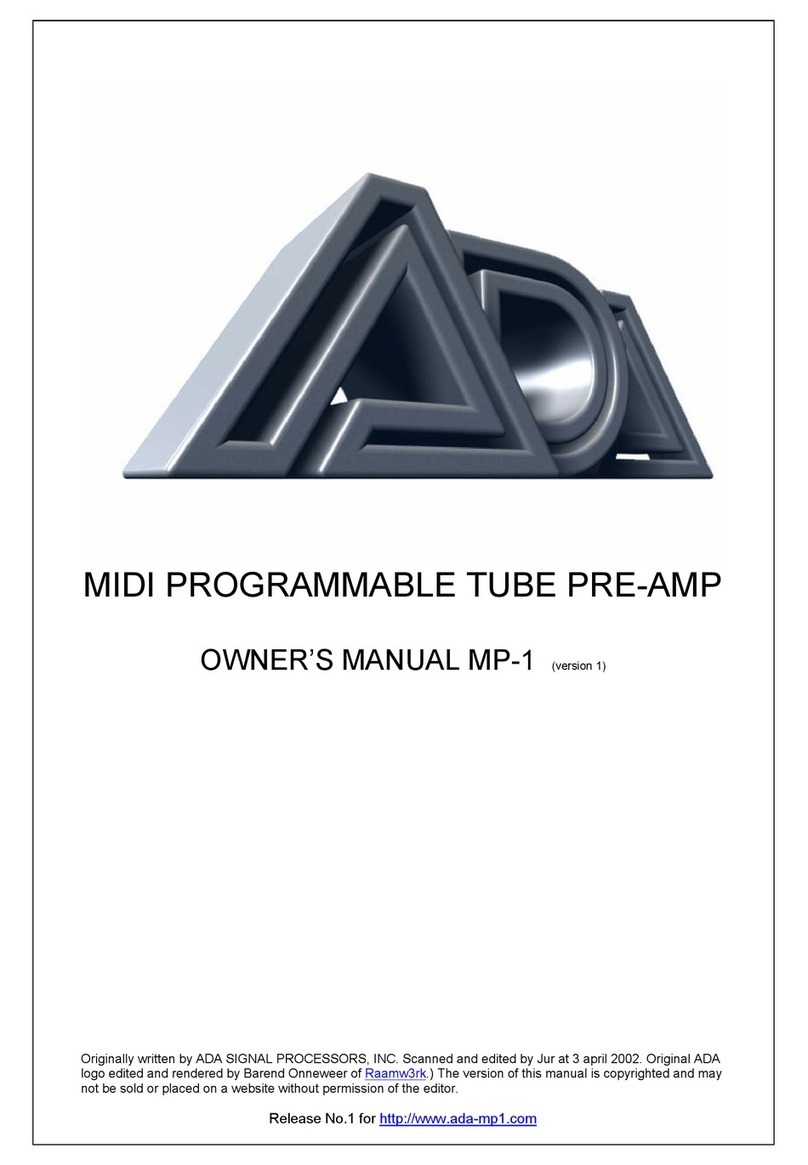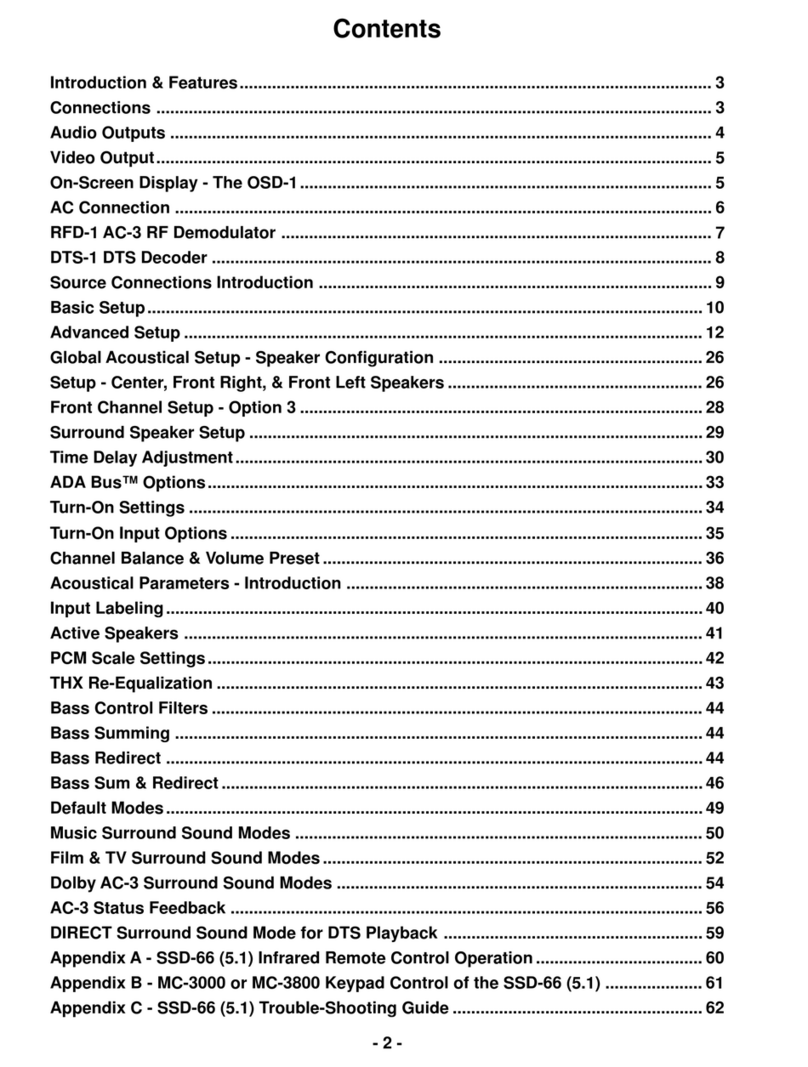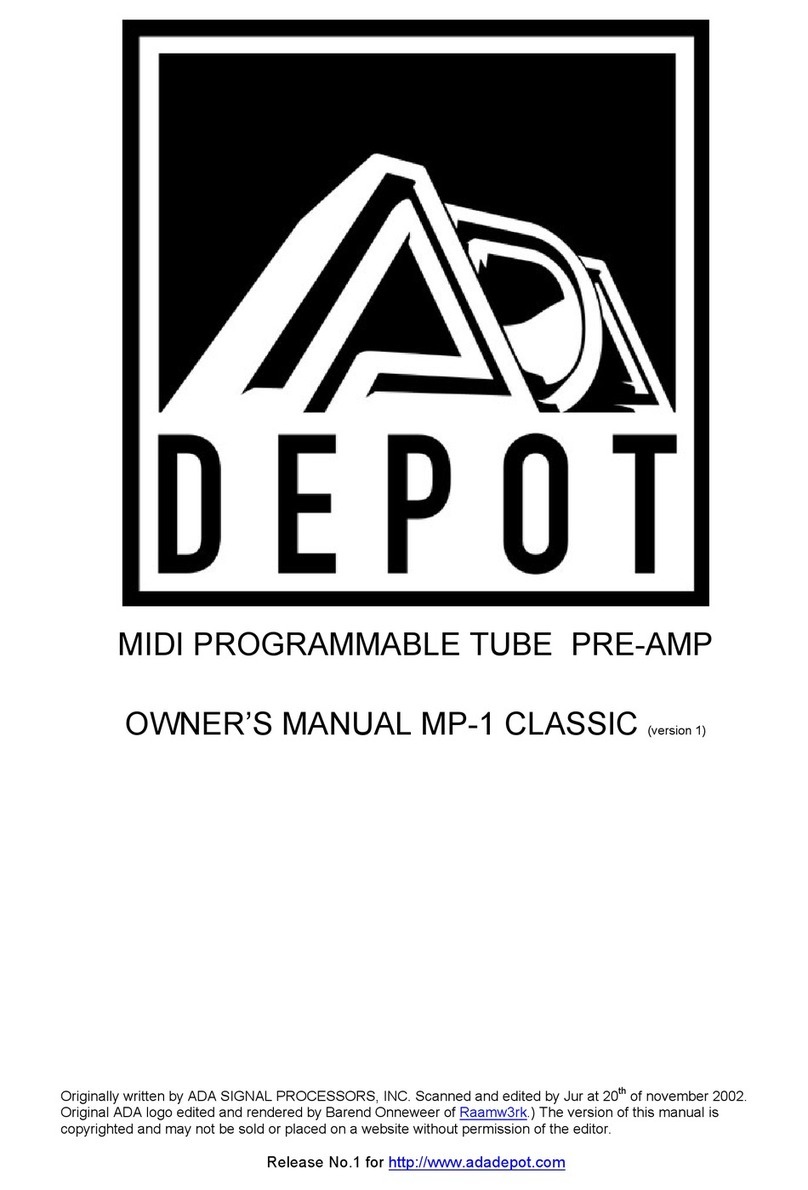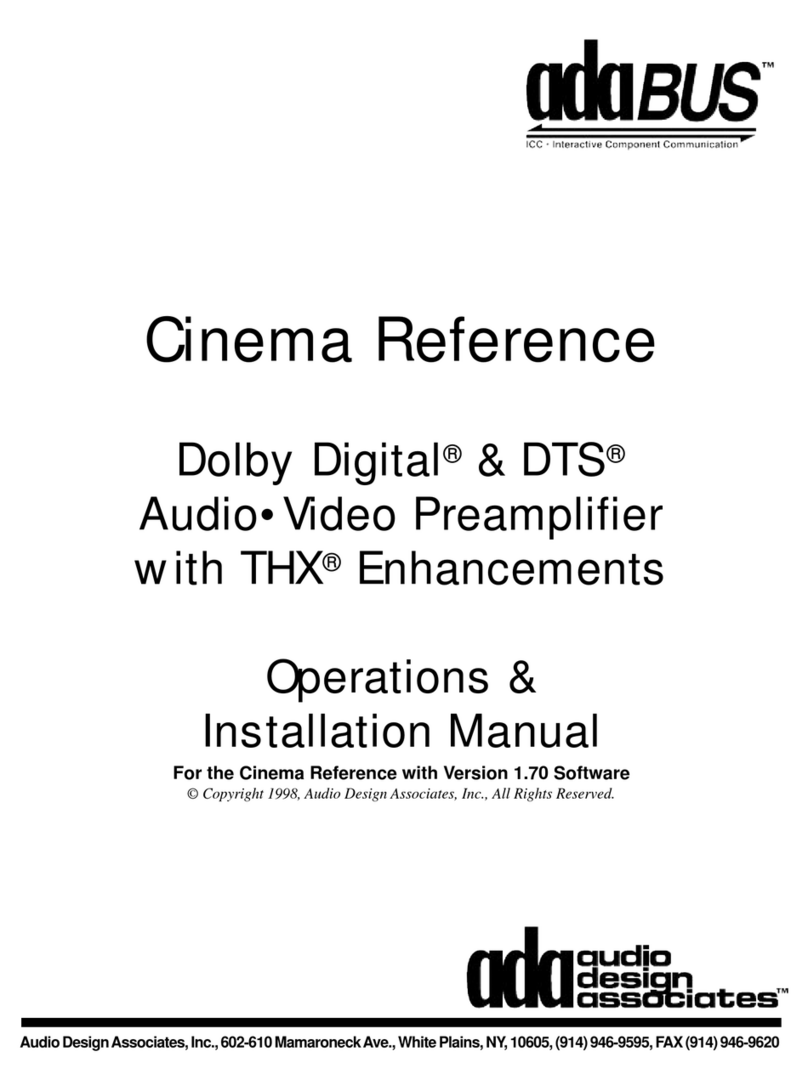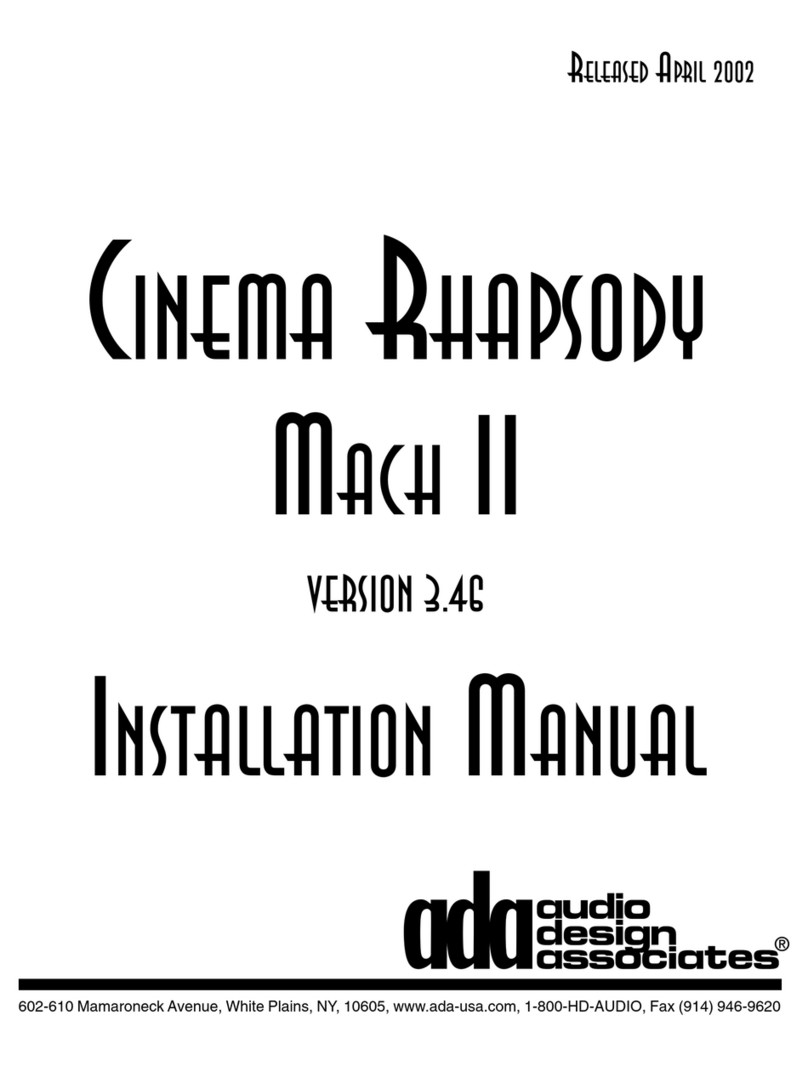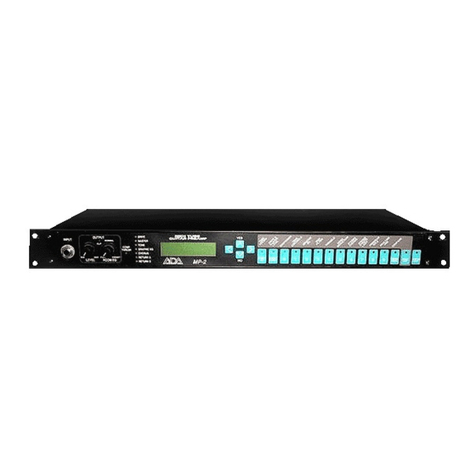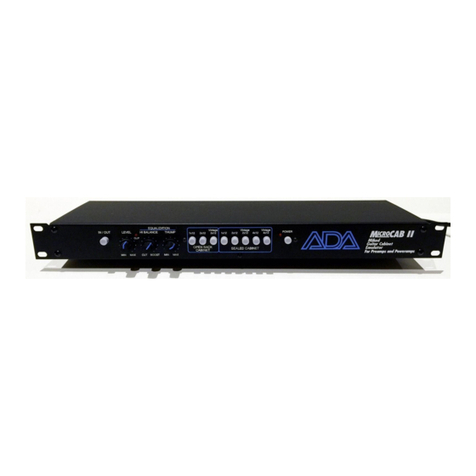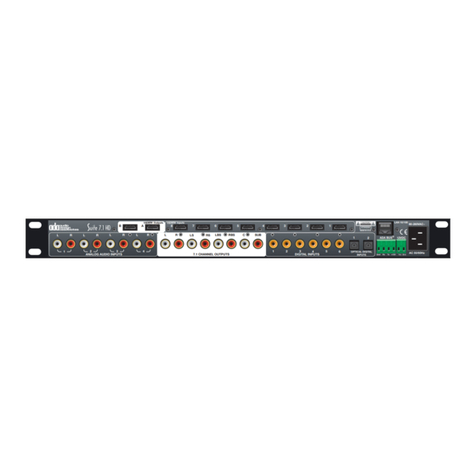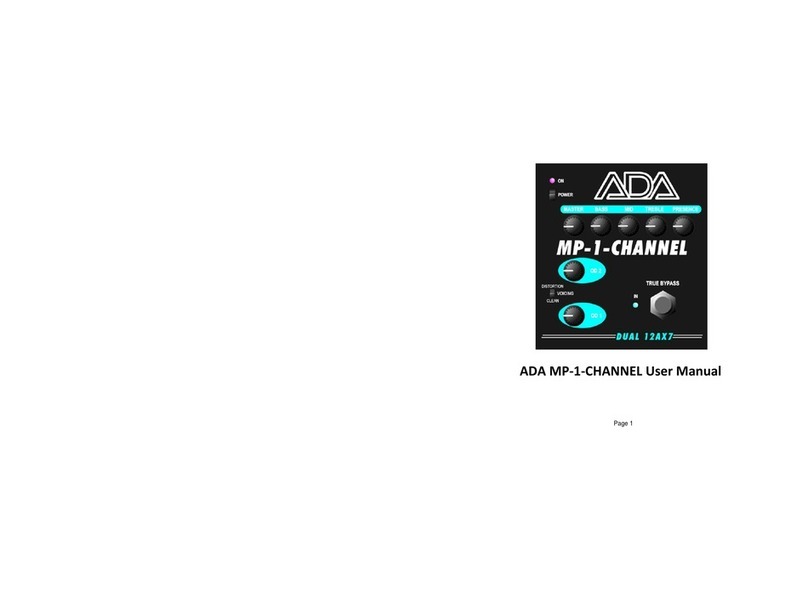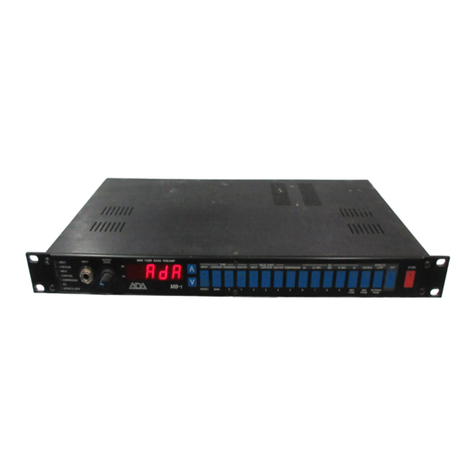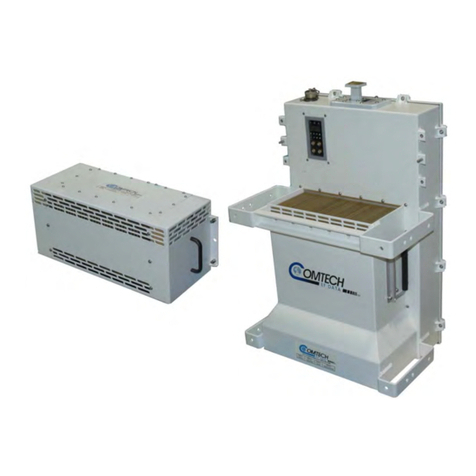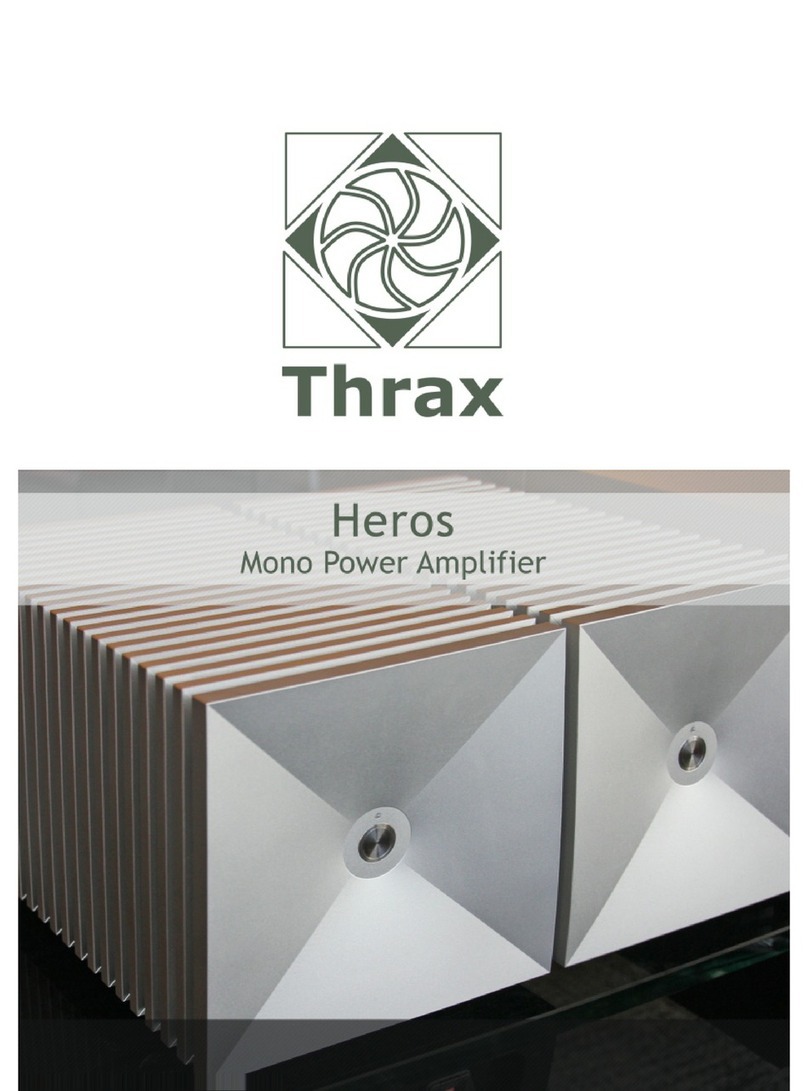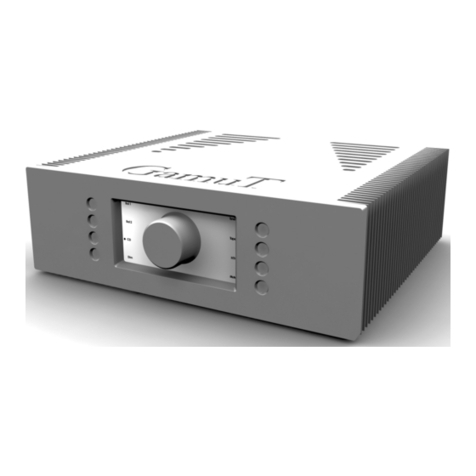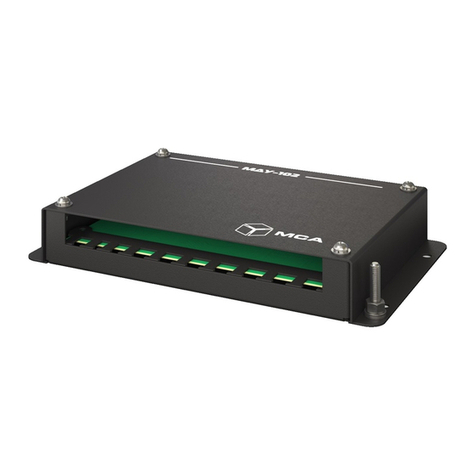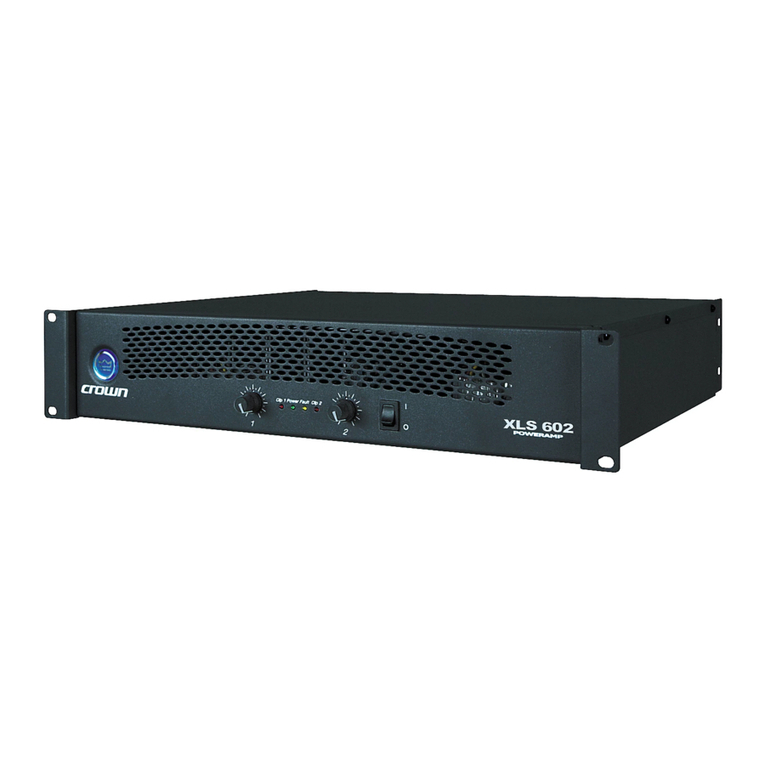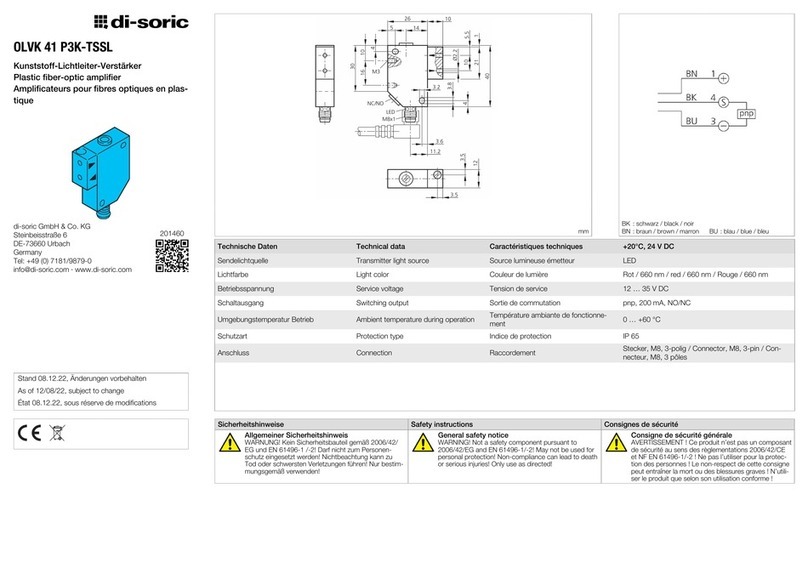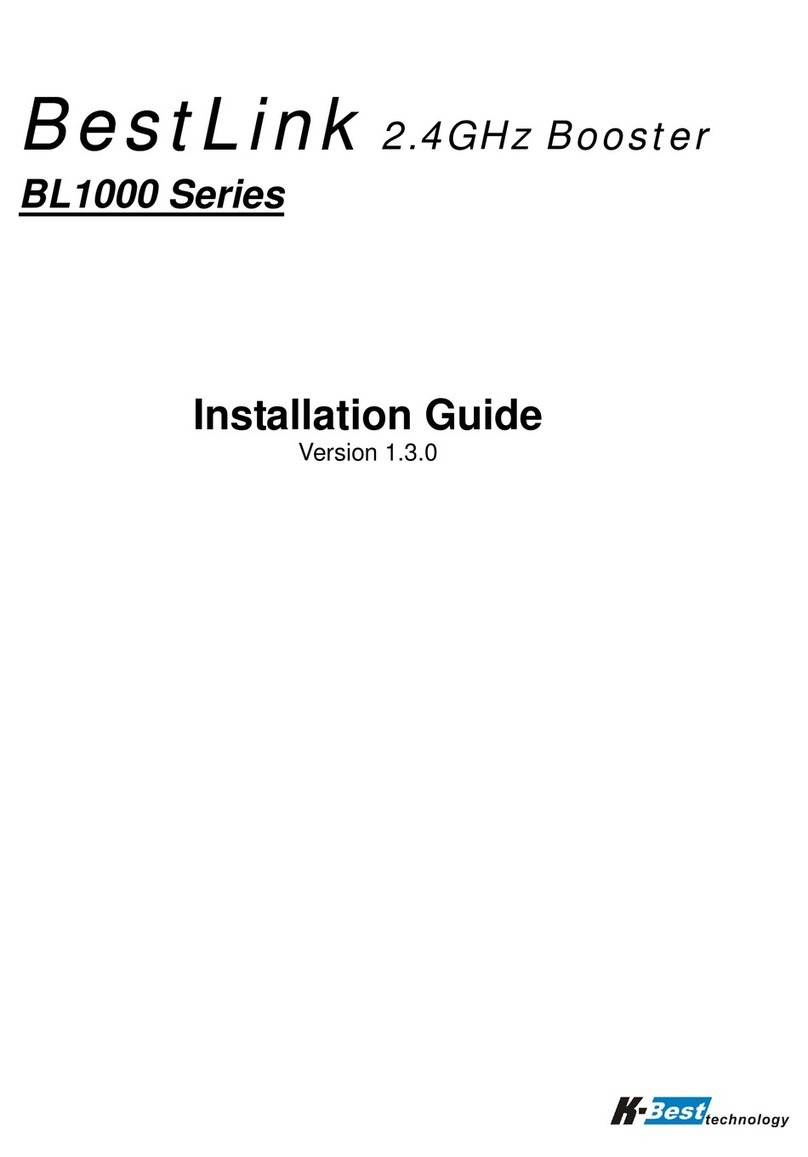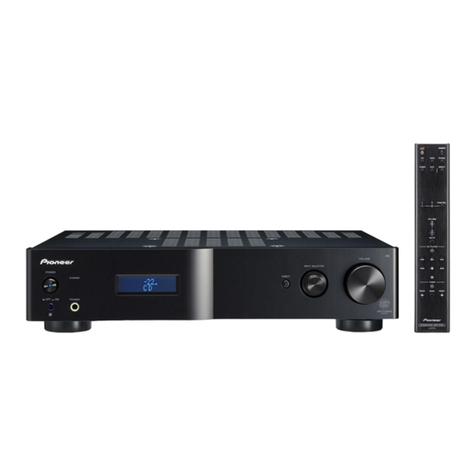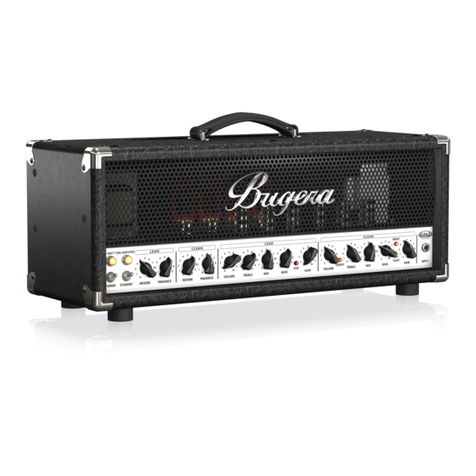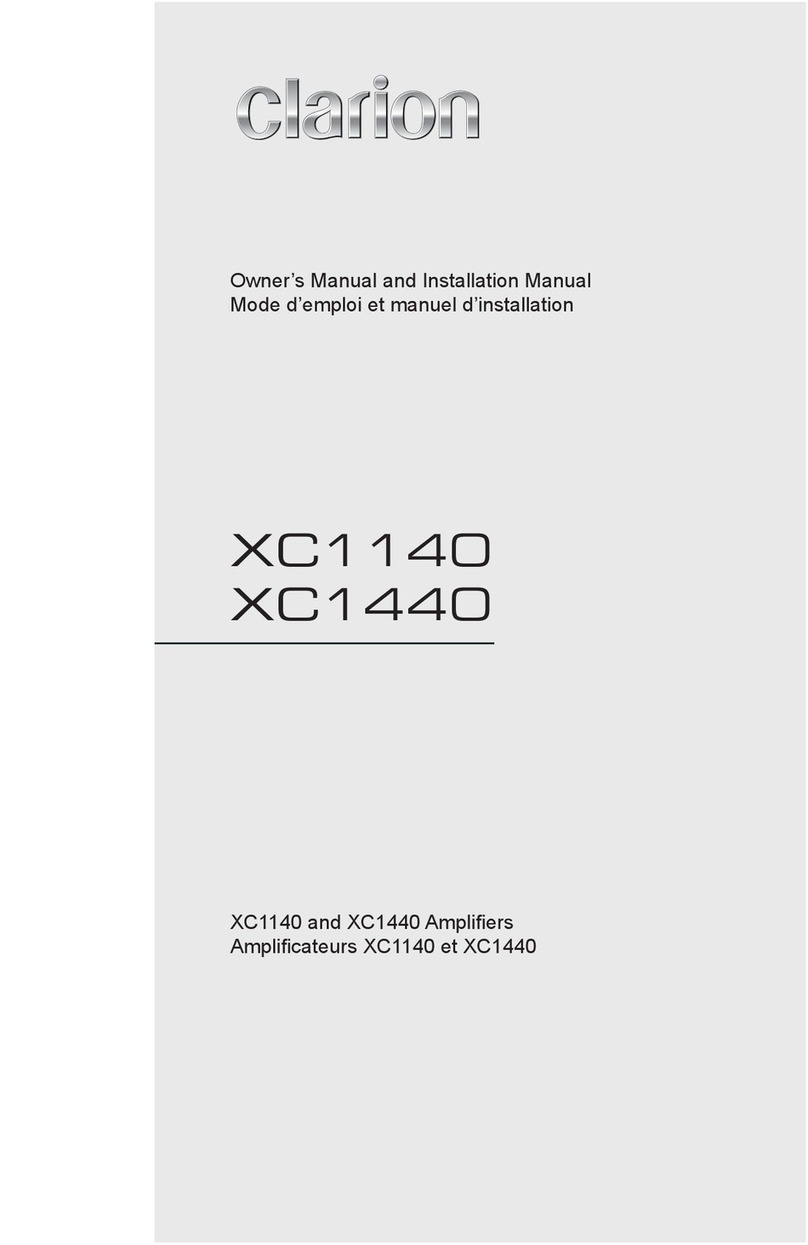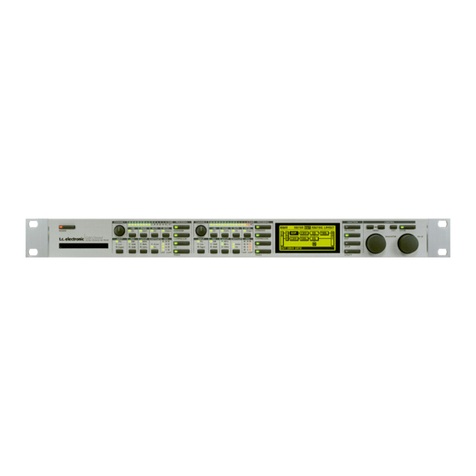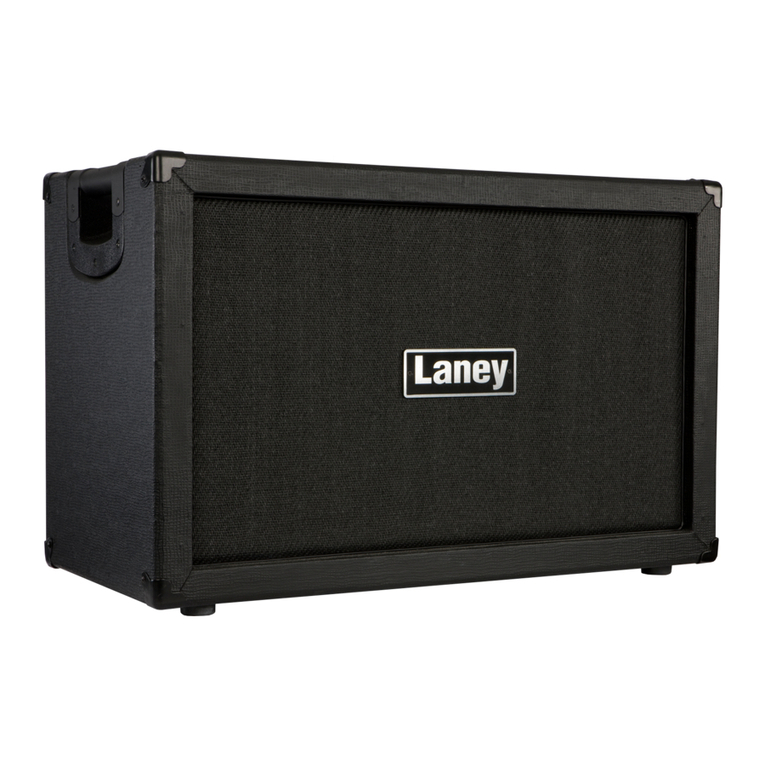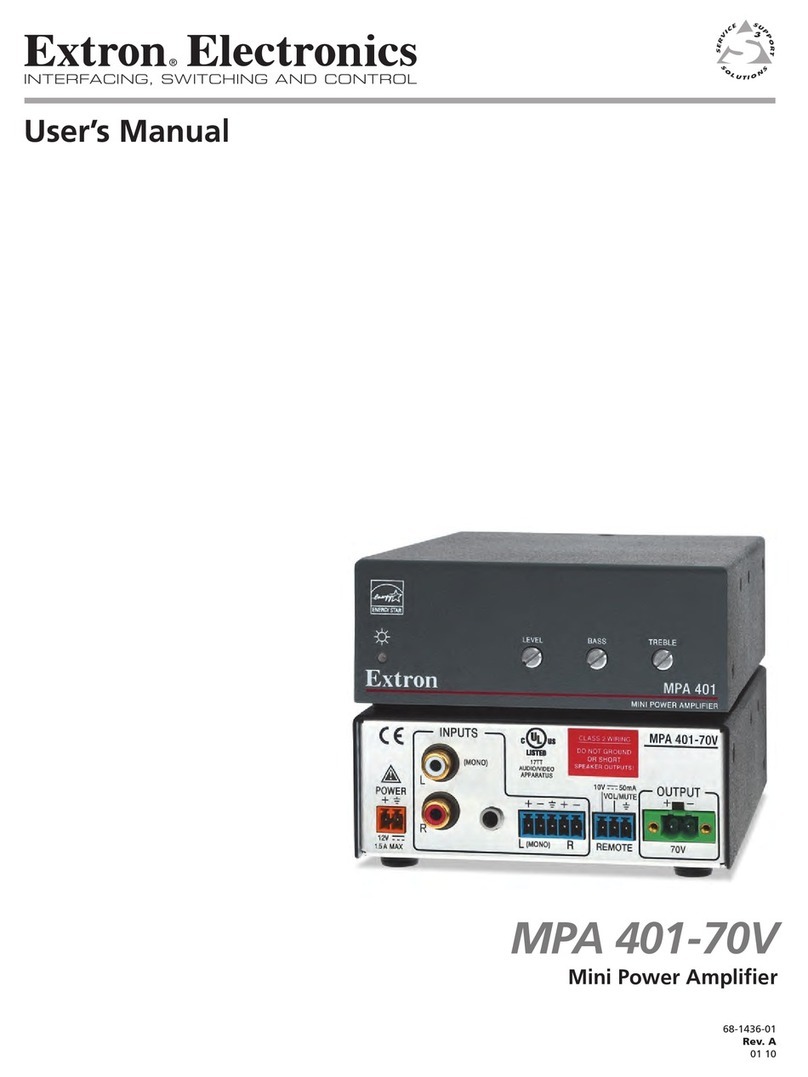A/DA MP-1 User manual

$'$ 6,*1$/ 352&(66256
$'$ 6,*1$/ 352&(66256 ,1&
' (GJHZDWHU 'ULYH 2DNODQG &$
3KRQH 7HOH[ )$;
Ada-mp1.pub
page 1 Saturday, 28 August 1999 23:14
Black

CONTENTS 1.0 INTRODUCTION
1.1 QUICK SET-UP GUIDE
1.2 FEATURES
1.3 PRECAUTIONS
2.0 CONTROL FUNCTIONS
2.1 REAR PANEL
2.2 BATTERY
3.0 INITIAL SET-UP
3.1 ACCESSING PROGRAMS
-CHANGE MEMORY NUMBER WITHIN
THE SAME BANK
-CHANGE TO NEW BANK AND
MEMORY NUMBER
3.2 EDITING AND STORING PROGRAMS
-EXAMINE PROGRAM PARAMETERS
-EDIT AND STORE A PROGRAM
3.3 CREATING TONE
3.4 USING THE CLIP LED’S
3.5 USING THE EFFECTS LOOP
3.6 LOAD PRESET PROGRAMS
4.0 MIDI FUNCTIONS
-SELECT MIDI CHANNEL
-SELECT PROGRAM & MEMORY NUMBER
4.1 ONE-TO-ONE MAPPING
4.2 REMOTE
5.0 SELF-DIAGNOSTICS
6.0 MEMORY PRESET SETTINGS
7.0 SPECIFICATIONS
7.1 MIDI SPECIFICATIONS
7.2 SOFTWARE UPDATES
8.0 RETURNING UNITS FOR SERVICE
9.0 WARRANTY
9.1 OPTIONAL EXTENDED WARRANTY
9.2 TUBE REPLACEMENT
10.0 SYSTEM EXCLUSIVE MESSAGES
10.1 SYSTEM EXCLUSIVE MAP
10.2 SYSTEM EXCLUSIVE PARAMETER VALUES
MIDI VALUE MASTER GAIN
DISPLAY VALUE
00
1.1
2.2
3.3
4.4
5.5
6.6
7.7
8.8
9.9
10 1.0
11 1.5
12 2.0
13 2.5
14 3.0
15 3.5
16 4.0
17 4.5
18 5.0
19 5.5
20 6.0
21 6.5
22 7.0
23 7.5
24 8.0
25 8.5
26 9.0
27 9.5
28 10.0
MIDI VALUE BASS & TREBLE
DISPLAY VALUE MID & PRESENCE
DISPLAY VALUE
0-16-12
1-12-10
2-9-8
3-6-6
4-4-4
5-2-2
6 OdB 0dB
722
844
966
10 9 8
11 12 10
12 16 12
Ada-mp1.pub
page 2 Saturday, 28 August 1999 23:14
Black

1.1 QUICK SET-UP GUIDE
Note: The MP-1 is a preamp and must be connected to a
power amp in order to play through loudspeakers.
INITIAL PREPARATION:
1 Connect guitar to front panel input jack.
2 Connect studio (line) level signals to the rear panel input
jack.
3 Connect amplifier to one of the two rear panel outputs. For
stereo, run both outputs to separate power amps.
4 If MP-1 outputs are connected to power amps (instead of
guitar amps) or a professional mixing console, flip the top
panel slide switch towards the rear panel to the Line
position.
5 Turn the power switch ON.
6 Adjust volume with Output Level control.
SELECT MEMORY NUMBER:
1 Use ∧ ∨ buttons to scroll through memory numbers 1 thru
128.
2 Or select a bank by pressing the BANK button, select bank
number 0 thru 12 using ∧ ∨ buttons, followed by pressing
any button labeled 0 thru 9.
CREATE THE RIGHT TONE
1 Press EDIT button.
2 Select VOICING button.
3 Use ∧ ∨ buttons to select Clean Tube, Distortion Tube, or
Solid State circuit.
4 Select Master Gain.
5 Use
∧ ∨ buttons to change level of drive from 1 to 10.
6 Repeat steps 4 and 5 for Overdrive 1 and 2. In Solid State
mode, the level of Overdrive 2 controls the amount of
compression.
7 Follow the same procedure for shaping EQ.
8 Select Chorus Depth button.
9 Use ∧ ∨ buttons to adjust depth from 0 to 100%.
10 Select Chorus Rate button.
11 Use ∧ ∨ buttons to adjust rate of sweep from .1 Hz to 10
Hz, or to turn rate off (0).
12 To abandon this edit session, press EDIT button. LED’s
turned off and changes not saved. To store changes, see
below.
HEX ADDRESS 1 BYTE EACH
00 Overdrive 2
01 Overdrive 1
02 Master gain
03 Bass
04 Midrange
05 Treble
06 Presence
07 Effects (0=Out, non-zero=In)
08 Depth (000=0ff, 100=Max value)
09 Rate (000=Off, 001=.1Hz, 100=Max)
0A Voicing (0=S.S., 1=Dist., 2=Clean)
10.1 SYSTEM EXCLUSIVE MAP
Marshall is a registered trademark of Jim Marshall Ltd.
Fender is a registered trademark of Fender Musical Instruments
Rockman is a registered trademark of Scholz Research &
Development, Inc.
Ada-mp1.pub
page 3 Saturday, 28 August 1999 23:14
Black

1.2 FEATURES
√ Unique Tri-State Voicing option for choice of Clean Tube,
Distortion Tube, or Solid State circuit for each program.
√ Two low-noise 12AX7A / 7025 tubes.
√ 128 programs.
√ Three programmable gain controls for each program.
√ Four band programmable EQ including 16dB boost / cut for
bass and treble.
√ Fully programmable stereo chorus and doubler.
√ Programmable effects loop with adjustable send / receive
level.
√ Stereo headphone jack with level control.
√ Stereo outputs switchable from line level (to mixing board) to
instrument level (to guitar amp).
√ 1/4” instrument level input jack on front panel for easy
access.
√ Active balanced input on rear panel for mixing boards.
√ Output level knob for fast volume adjustment without
affecting tone.
√ Programmable compression level in Solid State mode.
√ Received MIDI program numbers are re-assignable
(mappable) to any MP-1 memory number.
√ MIDI In, Out and Thru.
√ Selectable MIDI channel including ALL channels (OMNI) and
NO channels (OFF).
√ Lexan membrane switch front panel replaces pots. No
contamination from dust or liquids.
√ Optional MC-1 MIDI CONTROLLER footswitch provides
instant access to any program for on-stage control.
√ Self-diagnostics check unit during powerup.
√ Instantaneous logic-controlled FET switching.
√ EPROM updates will be available for future system
expansion.
√ State-of-the-art software implementation including SYSEX
and MIDI Time Code for computer-controlled applications.
√ Simple programming routine.
√ One year parts and labor warranty. Extended 3 year warranty
available.
SET PARAMETERS
<F0> SYSEX
<0D> ADA Identifier
<cc> Channel number
<dd> Device number
<06> Set parameter command
<PP> Pro
g
ram number
<NN> Number of parameters
<bb> Base parameter number
<V1> Parameter value
•
• .
• .
<VN> Parameter n value
<xx> Messa
g
e checksum
<F7> EOX
<F0> SYSEX
<0D> ADA Identifier
<cc> Channel number
<dd> Device number
<00> Response ID
<06> Response t
y
pe
<xx> Messa
g
e checksum
<F7> EOX
SET PARAMETERS RESPONSE
• Sets one or more parameters in a pro
g
ram
• Pro
g
ram number 7F specifies the current workin
g
parameter
re
g
isters.
• A zero response indicates no errors were detected, a non-zero
response indicates that a bad parameter number or value was
detected.
Ada-mp1.pub
page 4 Saturday, 28 August 1999 23:14
Black

DUAL FUNCTION SWITCHES:
IN NON-EDIT MODE
BANK Enter a Bank number (0 thru 12) by using the
∧∨buttons. After Bank selection, you must
select the “ones” digit using the buttons labled
(0 thru 9) to exit Bank select mode
0 THRU 9 Selects the “ones” digit of the memory
number.
MIDI CHNL Selects the MIDI channel mode. Use the ∧∨
switches to select the MIDI channel number
from 1 - 16, ALL (OMNI) or OFF.
PRGM Selects the external MIDI program number
that is assigned to the internal
memory
number on the MP-1. The normal relationship
is 1-to-1 (i.e., external MIDI program #1
selects internal memory #1, 2 to 2, etc.).
When the LED is lit, use the ∧∨ switches, the
bank switch and / or a number from 0 to 9 to
select the external MIDI program number.
MEM Selects the internal memory number on the
MP-1 that is assigned to the external
MIDI
program number. When the LED is lit, the
display reads the internal memory number.
Select the MEM number using the ∧∨
switches, the bank switch, and / or a number
from 0 to 9. To record the change, press the
switch again or press the PRGM button to
continue.
<F0> SYSEX
<0D> ADA Identifier
<cc> Channel number
<dd> Device number
<00> Response ID
<03> Response t
y
pe
<ss> Response (ma
y
be one or more b
y
tes)
<xx> Messa
g
e checksum
<F7> EOX
DIAGNOSTIC STATUS RESPONSE
• Retrieves the most recent dia
g
nostic result
• The first b
y
te of the response =0 if no error occurred, and ≠ 0 if an error
occurred.
• Some tests ma
y
return multiple b
y
tes on a device and test specific basis.
<F0> SYSEX
<0D> ADA Identifier
<cc> Channel number
<dd> Device number
<04> Device reassi
g
n command
<ee> New channel number
<ff> New device number
<xx> Messa
g
e checksum
<F7> EOX
DEVICE REASSIGN
DEVICE REASSIGN RESPONSE
<F0> SYSEX
<0D> ADA Identifier
<cc> Old channel number
<dd> Old device number
<00> Response ID
<04> Response t
y
pe
<ee> New channel number
<ff> New device number
<xx> Messa
g
e checksum
<F7> EOX
• Causes a device to switch channels or device numbers
Ada-mp1.pub
page 5 Saturday, 28 August 1999 23:14
Black

2.1 REAR PANEL
FUSE Externally accessable 0.5 AMP fuse. Replace
with equivalent type and rating only.
POWER SWITCH ON / OFF rocker switch (located near power
supply to prevent leakage of AC line hum into
the audio circuitry).
PHANTOM POWER A 9V AC / DC coaxial power input jack used to
supply phantom power to the optional MC-1
MIDI Controller or any other Phantom MIDI
Device. Use with a 7 - pin MIDI cable in the
MIDI IN jack, and do not connect an AC
adaptor to the MC-1’s rear panel power jack.
MIDI THRU Passes all MIDI data received at the MIDI IN
connector to subsequent MIDI instruments.
MIDI OUT Transmits MIDI information originated by the
MP-1 to subsequent MIDI instruments.
MIDI IN Receives MIDI. Permits MP-1 programs to be
automatically selected via a MIDI signal. The
MP-1 recognizes program change, SYSEX and
MIDI Time Code (MTC).
HEADPHONE:
JACK 1/4” stereo phone jack. Drives headphones of
600Ωor more.
LEVEL Provides full mute to +17dB above internal
signal level.
EFFECTS LOOP:
LEVEL Provides 20dB boost or cut to the send / receive
signal. Dual-gang pot insures unity gain at all
settings.
RECEIVE Single-ended 1/4” phone jack. Maximum signal
level is +30dBV.
SEND Single-ended 1/4” phone jack. Variable from
instrument to line level.
9.0 WARRANTY
The MP-1 (excluding tubes) is warranted against defects in material
and workmanship for a period of three hundred and sixty-five (365)
days from date of purchase. Original factory-installed tubes are
warranted against defects in material and workmanship for a period of
ninety (90) days from the date of purchase. ADA will replace defective
parts and make necessary repairs at no charge if factory inspection
reveals faulty workmanship or material. Neither MP-1 nor tube
warranties cover damage due to misuse, accident or neglect. ADA
retains the exclusive right to make such determination on the basis of
factory inspection. Products returned to the factory must first receive
authorization from ADA and must be shipped prepaid. The “return
authorization number” must be printed on the outside of the container
or the shipment will not be accepted by ADA. This warranty remains
valid only if repairs are performed by ADA, and provided that the serial
number on the unit has not been defaced or removed. This warranty is
expressly in lieu of all other warranties either expressed or implied.
9.1 OPTIONAL EXTENDED WARRANTY
An optional three year warranty is available on the MP-1 if the
extended warranty protection policy is purchased within the first 90
days of purchase. The policy covenants and restrictions are the same
as our standard one year warranty, only the term is increased an
additional three years after the original factory warranty expires.
Enclosed is an application for the extended warranty protection policy.
9.2 TUBE REPLACEMENT
Your factory installed 12AX7 tubes should last approximately
two years. Since these are not power tubes, the lifespan is probably
longer than you expect. When tube replacement becomes necessary,
we recommend that you use only ADA factory - tested replacement
tubes for the cleanest and quietest performance possible. These can
be obtained from ADA or an authorized ADA dealer. For more
information, call ADA Customer Service.
Ada-mp1.pub
page 6 Saturday, 28 August 1999 23:14
Black

3.0 INITIAL SET-UP
1 Set MP-1 rear panel POWER SWITCH to OFF.
2 Connect your guitar to the front panel INPUT jack. If you are
connected to a professional mixing console, run your signal source
to the LINE INPUT on the rear panel. If both inputs are connected,
only the front panel input will be operative.
3 Connect MP-1 OUTPUTS to your amplifier or mixer inputs.
4 If MP-1 outputs are connected to a power amp or other line input,
flip the top panel slide switch towards the rear panel to the LINE
position. WARNING: Do not use LINE position when MP-1 is
connectd to guitar amplifier inputs.
5 If using MIDI:
A. Connect the MIDI Out of your MIDI footswitch or other MIDI
controller to the MIDI IN jack on the MP-1.
B. When using a MIDI device before the MP-1 and a MIDI device
following the MP-1, use the MIDI Thru jack to send the external
program number. Use the MIDI Out jack to send the MP-1’s
internal memory number.
C. When using the MP-1 as the first in a series of MIDI devices,
use the MIDI Out jack to send the MP-1’s internal memory number.
6 If you own the optional MC-1 MIDI footswitch, connect the MIDI In
Jack on the MP-1 to the MC-1 with the MIDI CABLE. You can use a
standard 5-pin MIDI cable and plug the AC ADAPTOR into the
MC-1
or
you can use the ADA 7-pin phantom MIDI cable and power
the MC-1 thru the 7-pin cable (eliminating the need to have power
near the footcontroller); when using the 7-pin cable, the AC
ADAPTOR plugs into the 9V AC / DC jack on the MP-1 rear panel.
7 If you are using effects with the MP-1, connect the EFFECTS LOOP
SEND jack to the input jack of the first effect in use.
8 Connect the EFFECTS LOOP RECEIVE jack to the output of the
last effect in your loop.
9 See Section 3.4 for full description of correct effects loop level
settings.
DIMENSIONS L 10.5” x W 19” x H 1.75” (483x44x269 MM).
WEIGHT 6 lbs. (2.72 kg);
8 lbs (3.63kg)shipping.
OPTIONS 220VAC, 50 / 60 Hz,
Extended 3 year warranty,
Software updates,
ADA replacement tubes.
ACCESSORY MC-1 MIDI Foot Controller.
• All specifications subject to change without notice.
7.1 MIDI SPECIFICATIONS
SPECIFICATION 1.0, Rev 3.3
MIDI TIME CODE Recognized in Level 3 Software.
CHANNEL 1-16, OMNI, OFF
PROGRAM CHANGE External Programs: 1 - 128.
Internal Memory: 1 - 128, OUT. (bypass condition).
PARAMETER CHANGE
& DUMP SYSTEM Exclusive
7.2 SOFTWARE UPDATES
By sending in your warranty card, you are entitled to one free EPROM
software update. Thereafter, updates are $50 each. You can send your unit to
ADA for installation or we can send you the EPROM. Always refer to qualified
service personnel for installation.
When you power-up the MP-1, the software revision level is indicated on
the LED Readout before the word “ADA” flashes.
Level 1 software offers the following features: 100% compatability with
MIDI Spec 1.0. In addition, ADA has pioneered a phantom power system which
sends AC power thru a 7-pin MIDI cable to controllers such as ADA’s MC-1 MIDI
CONTROLLER.
Level 2 software offers upload and download of MP-1 parameters to
computers with a MIDI interface using System Exclusive Messages. In addition,
MP-1 parameters may be accessed in real-time using SYSEX messages.
Level 3 software will read MIDI Timecode for synchronizing with SMPTE
Time Code devices, and will be able store a Q-LIST of MTC program and
parameter changes.
These are the updates that we now know about. As MIDI evolves, so will the
MP-1. its capabilities will continue to expand!
Ada-mp1.pub
page 7 Saturday, 28 August 1999 23:14
Black

3.2 EDITING AND STORING PROGRAMS
The EDIT function is used to look at specific parameter values
and to create or modify a program
The STORE function is used to take the program you are
listening to in the Working Register and store it in a specific internal
memory number location. There are 128 locations.
To save your own
programs, you must use the STORE function. If you do not STORE
an edited program, it will be erased when you select a different
program.
When EDIT is pressed , the display reads “Edit”. From the
beginning of an edit session until the newly edited program has been
stored or abandoned, the MIDI interface is disabled. This prevents a
MIDI selected program from overwriting an edit session. Pressing the
EDIT button will exit the edit session. If you want to save your edit
session, press the STORE button to put the unit into the Store mode. If
a change is made to a parameter while in the Edit mode, the EDIT LED
will blink until the Edit mode is exited to remind you that if you don’t store
the program you will lose it if you select a different program to listen to.
The memory number will blink until the new data has been stored or
abandoned.
Once in Edit mode, pressing a parameter button selects an
alternate function for editing, illuminates the associated LED and puts
the current value on the display. Pressing the ∧ ∨ buttons will increment
or decrement the displayed value. If the button is held down, the display
value will increment or decrement until the maximum or minimum value
is reached.
EXAMINE PROGRAM PARAMETERS
1 Press BANK, press ∧ ∨ buttons until 0 is displayed on the tens digit
of the display, then press 1. You are now in program 1.
2 Press EDIT button.
3 Choose the OVERDRIVE 1. The value “5.0” is displayed on the LED
READOUT. Next, choose OVERDRIVE 2, its value is “5.0”.
Continue this process by examining MASTER GAIN, BASS, etc. An
LED on each button “blinks” when the parameter has been selected
for modification.
4 Press the EDIT button when you are through examining the
parameter values. The EDIT LED will turn off, and you will be
returned to Program 1.
6.0 MEMORY PRESET SETTINGS
The following 29 memory presets are loaded into the factory
preset Program Storage Registers
MARSHALL5.0 5.0 6.0 6 4 4 12 OUT 0 0 DIST
NOTCHED GRIND 4.8 3.2 8.0 4 8 6 12 OUT 21 0 CLEAN
LIQUID GRIND 6.0 6.0 7.0 2 2 4 6 OUT 14 1.2 DIST
EDGE RHYTHM 4.6 4.4 7.5 0 0 4 4 OUT 1 1 CLEAN
SATURATED
NOTCH 10.0 10.0 6.0 2 8 9 6 OUT 100 0 CLEAN
CLEAN WITH
COMPRESSION 4.0 4.0 9.5 2 0 4 4 OUT 1 1 S.S.
CLEAN & WARM 3.0 3.0 9.5 6 4 2 12 OUT 100 1 CLEAN
COMPRESSED
VIBRATO 4.0 9.0 7.5 0 12 6 10 OUT 34 9.0 S.S.
OVER
CHORUSED
CLEAN
2.6 6.5 10.0 4 10 12 4 OUT 30 1.8 S.S.
BEEFY FENDER3.0 9.0 6.5 0 4 9 2 OUT 0 0 CLEAN
BRITTLE RHYTHM 3.0 3.0 7.5 4 4 9 8 OUT 30 .3 DIST
CHORUSED LEAD 9.0 5.5 5.5 4 4 2 10 0UT 23 1 DIST
CLASSIC CLEAN 3.6 5.0 7.5 2 4 16 12 OUT 0 0 S.S.
SHIMMERING
CLEAN 2.8 2.4 10.0 0 10 16 12 OUT 54 1.2 CLEAN
SLAP FUNK 10.0 10.0 8.5 2 8 4 8 OUT 28 0 S.S.
FLANGED
ROCKMAN4.4 4.4 6.0 2 8 4 10 OUT 100 .3 DIST
TUBULAR METAL 10.0 3.6 7.5 2 12 2 2 OUT 14 0 DIST
CLEAN FLANGE 5.0 1.4 9.5 6 0 4 12 OUT 100 1 S.S.
STRAIGHT
AHEAD METAL 3.8 7.0 7.0 2 6 0 4 OUT 0 0 DIST
CLASSIC
OVERDRIVE 5.0 5.5 7.5 6 12 4 6 OUT 47 0 CLEAN
DAMPED LEAD 9.5 9.0 7.0 9 6 6 8 OUT 100 0 CLEAN
NOTCHED LEAD 10.0 4.8 5.5 6 4 6 12 OUT 100 0 DIST
DRY LEAD 7.0 5.5 5.5 4 4 9 8 OUT 0 0 DIST
ROCKMAN9.53.05.50 6124OUT680DIST
CRYSTAL CLEAN 4.0 8.5 8.0 9 6 6 8 OUT 100 0 S.S.
SPARKLING
CHORUS 2.6 2.6 10.0 9 4 9 12 OUT 26 .3 CLEAN
COMPRESSED
CHORUS 4.2 10.0 6.5 9 4 16 12 OUT 100 .2 S.S.
MILD GRIND 4.2 4.2 7.0 9 8 2 12 OUT 100 1 CLEAN
COMPRESSED
RHYTHM 5.0 8.0 8.5 4 8 6 12 OUT 60 0 S.S.
MEM
NO. PARAMETER
PROGRAM OD1 OD2 MASTER BASS MID TREBLE PRSNCE LOOP DEPTH RATE VOICING
1
2
3
4
5
6
7
8
9
10
11
12
13
14
15
16
17
18
19
20
21
22
23
24
25
26
27
28
29
Ada-mp1.pub
page 8 Saturday, 28 August 1999 23:14
Black

In the SOLID STATE mode, OVERDRIVE 2 functions as your
compression control. The higher the value, the more compression you
have, to a maximum of approximately 40dB. Use the compression to
soften your attack and achieve better sustain.
The MASTER GAIN sets your pre EQ level. When the MASTER
GAIN button is selected, the ∧ ∨ buttons will change the value from 0 to
10. As you create programs (the EDIT LED on), any change of the
VOICING mode will reset the MASTER GAIN level to 0. This is
necessary to supress any loud surprises.
The stereo analog CHORUS is a perfect complement to the
warmth of the MP-1’s tube circuitry, but it will do more than produce
great chorusing. If you set the CHORUS RATE to 0 (off), the CHORUS
DEPTH functions as a very short delay, producing a wide range of notch
filter and doubling effects. You can achieve a hollow, out-of-phase
“Strat”-type sound, and fine-tune it by taking the CHORUS DEPTH value
up or down.
3.4 USING THE CLIP LED’S
Your MP-1 is digitally controlled. The MP-1 circuit is monitored in
four points for clipping of the digital controls to help you prevent
unwanted kinds of distortion from coloring your tone. Always pay
attention to your CLIP LED’S. If a CLIP light remains on while you play,
you should lower the value of the control that is indicated. If you like the
tone that you have, you can still keep that tone, but eliminate the
unwanted clipping.
For example, if the EQ is clipping, but you want the same curve,
you can either lower the MASTER GAIN (signal going into the EQ), or
lower all of the EQ values the same amount.
3.5 USING THE EFFECTS LOOP
The EFFECTS LOOP LEVEL control on the rear panel will allow you to
achieve the quietest possible performance, no matter what kind of
effects you are using. The level control is configured to insure that you
have the same overall signal level whether the effects loop is in or out,
provided the effects in the loop are set for unity gain.
SELECT PROGRAM & MEMORY NUMBER
1 Connect the MIDI Out of a MIDI device to the MIDI IN jack on the
MP-1. Test if reception is occurring by changing programs on the
sending device. As you change programs on the external device, the
MP-1’s LED display will change.
2 Press PRGM. The LED flashes.
3 Select a new PRGM number by (a) scrolling through the program
numbers with the ∧∨ buttons, or (b) go directly to a program using
the BANK, ∧∨ and 0-9 buttons.
4 Press MEM. LED flashes.
5 Select a new MEM number by (a) scrolling through the program
numbers with the ∧∨ buttons or (b) go directly to a program using
the BANK, ∧∨ and 0-9 buttons.
6 Press MEM to store and exit.
4.1 ONE-TO-ONE MAPPING
The MP-1 is shipped with a 1-to-1 program / memory map, i.e.,
external MIDI program 1 is mapped to internal memory 1, external 2 to
memory 2, etc. If you want to restore the 1-to-1 relationship:
1 Press STORE. STORE LED will blink.
2 Press BANK, hold down and simultaneously press 2.
Display reads “Load”.
4.2 REMOTE
The ADA MC-1 is a universal MIDI CONTROLLER that permits
sending program change commands to the MP-1 and the rest of your
MIDI equipment.
Two options exist for using the MC-1 with ADA equipment. First
you can use an ADA 7-pin MIDI CABLE to phantom power the MC-1.
This prevents the need to run AC power to the footswitch (the AC
ADAPTOR is connected to a jack on the rear of the MP-1 labeled 9V
AC/DC). Second, you can use a standard 5-pin MIDI cable and plug the
AC ADAPTOR directly into the MC-1.
Ada-mp1.pub
page 9 Saturday, 28 August 1999 23:14
Black

4.0 MIDI FUNCTIONS
The MP-1 has MIDI In, Out and Thru and recognizes program
change, SYSTEM Exclusive and MIDI Time Code.
To send and receive MIDI data, you must select a MIDI channel.
You have the option of selecting an individual MIDI channel, (1-16), or
you can send or receive on all 16 MIDI channels (OMNI) or you can turn
MIDI off.The MP-1 has 128 storage registers for programs. These are
referred to as “internal memory”. The MP-1 allows you to “map” MIDI
program numbers received via MIDI IN to any “internal memory”
numbers you choose. For example, if you have a MIDI foot controller
connected to the MP-1, sending program change 11, the MP-1 could
“map” the reception of program 11 to memory 22 or any memory
location from 1 thru 128 in the MP-1. This gives you the potential of
“mapping” more than one MIDI program command to the same MP-1
memory number. Other MIDI devices without this feature limit you to a
one-to-one relationship, e.g., when you change to program 11 on your
foot controller, the receiving device can change only to program 11.
When the PRGM or MEM buttons are in use and their
corresponding LED is flashing, the MIDI interface is temporarily
disabled. If the MP-1 is left with the PRGM button active, the MP-1 will
display program numbers when they are received instead of internal
memory numbers.
The external MIDI PRGM number range is from 1-128. The
internal MEM number range is from 1-128.
SELECT MIDI CHANNEL
1 Press MIDI CHNL. To select a number from 1 thru 16, ALL (OMNI),
or MIDI OFF, use the ∧∨ buttons to make your selection. When the
display reads “ALL”, the MP-1 will talk and listen to all 16 MIDI
channels simultaneously. When the display reads “OFF”, the MP-1
will not talk or listen to any MIDI channel.
Be sure to set the MIDI
device connected to the MP-1 to the same MIDI channel as the
MP-1.
(If you do not know the MIDI channel being sent by the device
preceeding the MP-1, set to ALL).
2 After selection has been made, press MIDI CHNL to save and exit.
Follow this general procedure:
1 If you are using an effect with only one level control, set your effects
device to unity gain. You can test for unity gain by connecting the
EFFECTS SEND to your effect input, and running the effect output
directly to your amp. Adjust the level on your effects device so that
you have the same volume when the effect is switched in or out.
2 Set the EFFECTS LOOP LEVEL at the highest possible setting
without clipping the effect’s input.
3 If you are using a line level effect with two level controls, set your
EFFECTS LOOP LEVEL control to 1 o’clock (0 dB gain). Adjust the
input level on your effect to the highest possible setting without
clipping, and set the output level control on your effect to achieve
unity gain in your effect. You can test for unity gain as described in
step 1.
4 Check for distortion and excess noise. If your effect is clipping, turn
your EFFECTS LOOP LEVEL control counterclockwise.
3.6 LOAD PRESET PROGRAMS
There are 29 factory preset programs (1-29) that can be loaded
into the internal program memory via the front panel. These can be
loaded at one time, or they can be brought into the MP-1’s working
register one at a time (Level 2 software). To load all 29 programs, press
the STORE button. The STORE button will blink. Press BANK and, while
holding it down, press 1. Display reads “LP” (Load Programs). Programs
1 thru 29 will be erased and overwritten by the preset programs.
Reference section 6.0 MEMORY PRESET SETTINGS for a description
of factory presets. To load just one program (Level 2 sofware), press
BANK and while holding it down, press CHORUS RATE. “P” will be
displayed, indicating that a preset is being recalled. Now select the
preset you want by using ∧∨. You may use or edit this program without
erasing any of your own programs, or you may save it by using the
STORE sequence.
Ada-mp1.pub
page 10 Saturday, 28 August 1999 23:14
Black

5.0 SELF DIAGNOSTICS
The MP-1’s self-diagnostic program checks the unit for errors
during power-up. This interactive feature pinpoints the source of
problems to simplify correcting the problem.
The following chart shows the error code that will be displayed in
the event of a problem, the cause of the problem, and the appropriate
action for you to take. ERROR CODES
DISPLAY CAUSE ACTION
Err 1 MIDI map checksum error. All
MIDI program numbers are set
1:1 with internal memory
numbers.
Re-enter MIDI
map
assignments.
Err 2 Working register checksum
error. All values of stored
parameters in the working
register are set to default
values. All are set to 0 except
effects loop is set to “out” and
the clean channel is selected.
Call up another
program
number or re-
enter parameter
values via Edit
session.
Err 3 MIDI control parameters check-
sum error. All parameters set to
default values: MIDI = OFF,
MIDI internal # = 1, most
recently received MIDI program
= 1, current program = 1 and
display flashes.
Re-enter MIDI
parameters via
front panel.
Err 4 MIDI Time code cue-list check-
sum error. Cue-list is erased
and flag is set to respond with
error message when MTC
status request is sent to the
MP-1.
Re-load cue-
list.
[None] Indicates the program itself has
an error. Program will not
display anything and unit will not
operate.
Check fuse. If
good, unit
requires service
EDIT AND STORE A PROGRAM
1 Press the EDIT button.
2 Choose a parameter such a s MASTER GAIN and decrease or
increase its value with the ∧∨ buttons.
3 Proceed to the next parameter following the same procedure as 2 .
above.
4 After all changes are complete, press the red STORE button.
5 Increment or decrement to a bank number, and select a memory
number from 0 - 9 that you want to assign to the program. The
program is now stored in the selected location.
3.3 CREATING TONE
When the EDIT button is toggled on, you have access to the
MP-1’s gain and tone controls ( gray area ). The MP-1 has a unique
VOICING control which allows you to create programs using ultra-high-
gain DISTORTION TUBE ( display reads
TUBE
with
DIST
LED lit on
the far left of the display ), CLEAN TUBE (
CLEAN
LED lit ), or SOLID
STATE ( display reads S.S. ). When the VOICING button is selected,
use the ∧∨ buttons to access these three choices.
The DISTORTION TUBE voice filters the pre-tube input signal
for super-saturated distortion. The processor control biases the tubes for
extra high gain tone. When the CLEAN TUBE is selected, the processor
re-biases the tubes for clean tones. It also re-filters the input signal to
give you full-range frequency response for warm Fender- type sounds.
The SOLID STATE voice bypasses the tube circuitry. This will give you a
complete range of solid state sound, including chorus, adjustable
compression, and notch filtering.
When setting your OVERDRIVE levels, remember that low
levels followed by high levels produce more noise than the reverse. High
levels of OVERDRIVE 1 will produce a distortion that has high frequency
harmonic saturation, whereas high levels of OVERDRIVE 2 will produce
fuller harmonic saturation. When OVERDRIVE 1 or OVERDRIVE 2 is
selected, use the ∧∨ butons to change the levels from 0 to 10.
Ada-mp1.pub
page 11 Saturday, 28 August 1999 23:14
Black

7.0 SPECIFICATIONS
EQ Bass and Treble boost / cut 16dB; Mid
and Presence boost / cut 12dB.
TUBE COMPLEMENT Four stages of gain using two low
noise 12AX7 / 7025 tubes.
MIDI Specification: 1.0 Rev 3.3;
Channel: 1 - 16, OMNI, OFF;
Program Change: external programs
1-128, internal memory 1-128 and
OUT ( bypass );
MIDI Time Code (MTC): recognized in
Level 3 Software;
Parameter Change & Dump:
SYSTEM Exclusive.
CHORUS DEPTH 0 ( none ) to 7:1.
CHORUS RATE 0.1 sec. to 10 sec. and off (0).
INPUT, FRONT PANEL One, 1/4” phone jack, high imped-ance
( 1 meg ohm ) wide range input.
INPUT, REAR PANEL One, 1/4” phone jack, active bal-anced
(30k ohm). Ring, tip, sleeve.
OUTPUTS Two, single-ended 1/4” phone jacks.
Synthesized complementary stereo
outputs. Switchable from instrument to
line level.
EFFECTS LOOP, SEND Single-ended 1/4” phone jack. Variable
from instrument to line level. Maximum
drive on send line is
+ 19dBm.
EFFECTS LOOP, RECEIVE Single-ended 1/4” phone jack.
maximum signal level is + 30dBv.
EFFECTS LOOP, LEVEL Provides 20dB of inversely proportional
boost or cut to the send / receive
signals. Interfaces with low-level and
line-level effects.
HEADPHONE LEVEL Provides full mute to + 17dB above
internal signal level. Max output +
12dBm.
HEADPHONE ( JACK ) 1/4” stereo phone jack. Drives
headphones of 600 ohms or more.
POWER CONSUMPTION 12 watts.
POWER 120VAC, 50 / 60Hz.
10 Set your effect(s) power switch to the “on” position.
11 Set MP-1 rear panel POWER SWITCH to “on”.
12 Set your amplifier’s power switch to the “on” position.
13 The MP-1 will now step through its SELF_DIAGNOSTIC program,
checking a variety of functions for proper operation. If no problem
exists, the DIAGNOSTIC operation is completed within eight
seconds. Your MP-1 is now ready for operation. ( If a problem does
occur, reference Section 5.0 SELF CHECK DIAGNOSTIC for
explanation of error codes).
14 Observate the CLIP LED’s. Remember, in order to maintain
maximum performance with the least amount of noise and distortion,
proper level setting is necessary. If a CLIP LED remains on as you
play, an adjustment of the program setting is necessary. See Section
3.4 for a complete description.
3.1 ACCESSING PROGRAMS
The MP-1 is shipped from the factory with 29 preset programs.
Please note that the amount of overdrive in any program will depend on
the type of pickups you are using. For example, single coil pickups will
require higher levels of OVERDRIVE 1 than hotter dual-coil pickups to
achieve the same amount of distortion. See Section 3.3.
As you store your own programs into memory locations, you
erase the formerly stored program values in the respective registers.
However, you can always recall the original factory preset programs, so
feel free to experiment.
CHANGE MEMORY NUMBER WITHIN THE SAME BANK
1 EDIT and STORE LED’s off.
2 Press the desired program number button ( 0-9 ).
Only a single
keystroke is required when changing the “ones” digit in a program.
3 ALTERNATE TO 2. .... You can also use the ∧∨ buttons to scroll
through the numbers.
CHANGE TO NEW BANK AND MEMORY NUMBER
1 Press BANK button.
2 Select bank number 0 through 12 using ∧∨ buttons.
3 Select “ones” digit by pressing any button labled 0 through 9.
4 ALTERNATE TO 2. & 3. ...hold down the ∧ or the ∨ button with the
BANK function off. The number scrolls and wraps around from 1 to
128 in either direction.
Ada-mp1.pub
page 12 Saturday, 28 August 1999 23:14
Black

OUTPUT (A&B) Two single-ended 1/4” phone jacks.
Synthesized complimentary stereo outputs.
OUTPUT LEVEL Switchable from instrument level ( INST ) to line
level ( LINE ). Set output level with slide switch
on top panel. WARNING: Do not connect MP-
1 to guitar amplifier input with the OUTPUT
LEVEL in the LINE position.
LINE INPUT 1/4” phone jack for line level input signals.
Active balanced ( see below ).
INPUT, 30K Ω
RING, NEG
TIP, POS
SLEEVE, GND
2.2 BATTERY
The MP-1 uses a 3-volt Lithium battery which maintains power
for program storage while the MP-1 is unplugged from an AC supply.
Expected battery life is 8 - 10 years. Should replacement be necessary,
contact a qualified service technician.
8.0 RETURNING UNITS FOR SERVICE
If your unit requires service, please do the following:
1 Call our Customer Service Department toll-free at:
(800) 241-8888
in CA (415) 632-1323
for a Return Authorization ( RA ) number.
2 Pack unit in its original carton with packing materials and include a
note explaining the problem, your name, address, daytime phone
number, and date and place of purchase.
3 Write the RA number on the outside of the shipping container.
4 Ship via UPS, Federal Express, or U.S. Postal Service. You pay the
freight. We recommend that you insure the unit.
5 If the unit is under Warranty, ADA will perform the servicing and pay
the return shipping charges to you. If your Warranty Card was
returned, there is a record of your purchase on file at ADA.
Otherwise, send a copy of your original purchase invoice for proof of
Warranty coverage.
6 If the unit is not under Warranty, ADA will bill you for the servicing
and return shipping charges. We require payment in advance or
cash on delivery ( COD ) for these charges.
Ada-mp1.pub
page 13 Saturday, 28 August 1999 23:14
Black

10.0 SYSTEM EXCLUSIVE MESSAGES
RESET DEVICE
<F0> System Exclusive Message ID (SYSEX)
<0D> ADA Identifier
<cc> Channel number
<dd> Device number
<01> Reset Device command
<xx> Message checksum
<F7> End of system exclusive (SYSEX)
<F0> SYSEX
<0D> ADA Identifier
<cc> Channel number
<dd> Device number
<03> Report diagnostic status
<xx> Message checksum
<F7> EOX
RUN DIAGNOSTIC TEST
• Causes the specified device to run a selected diagnostic test routine.
• Test 00 is equivalent to power-on diagnostic.
• Other test numbers are device specific.
• No response is sent by the device.
• Causes the specified device to perform a reset operation.
• Specifics of the reset are device dependent.
• No response is sent by the device.
REPORT DIAGNOSTIC STATUS
<F0> SYSEX
<0D> ADA Identifier
<cc> Channel number
<dd> Device number
<02> Run diagnostic test command
<tt> Test number
<xx> Message checksum
<F7> EOX
IN EDIT MODE
VOICING Allows choice for each program of Clean Tube,
Distortion Tube, or Solid State circuits. Use ∧∨
switches to step through choices when Voicing
switch is selected.
OVERDRIVE 1 Attenuates pre-tube input signal. Higher gain levels
of Overdrive 1 result in higher frequency harmonic
saturation.
OVERDRIVE 2 Attenuates inter-tube signal. Higher levels of
Overdrive 2 result in fuller harmonic saturation. In
the Solid State mode, Overdrive 2 sets the level of
compression.
MASTER GAIN Post-tube, pre-EQ gain.
BASS Narrow band low frequency EQ control adjustable in
2dB steps ± 16dB.
MID Wide band mid frequency EQ control adjustable in
2dB steps ± 12dB.
TREBLE Narrow band high frequency EQ control adjustable
in 2 dB steps ± 16dB.
PRESENCE Wide band high frequency EQ control adjustable in
2dB steps ± 12dB.
CHORUS DEPTH Adjusts the sweep depth from 0 to 100% for a
maximum range of 7:1. When the Chorus Rate is
set to 0 (off), the Depth control will vary the delay
time to create different filtering and doubling effects.
CHORUS RATE Adjusts the speed of the sweep from .1Hz (1 cycle
per 10 seconds) to 10Hz (10 cycles per second), or
off (0).
EDIT Place the MP-1 into the Edit mode. The display
reads “Edit” until a parameter is selected. Display
then shows the value of the selected parameter.
Use the ∧∨ buttons to increase / decrease the value
of the selected parameter.
STORE Place the MP-1 into the Store mode. Stores any
current or edited program into any internal memory
location. Press the STORE button followed by a
memory location. LED indicates Store mode is
engaged. LED turns off after storage is complete. If
you decide not to store the current program, but
you’ve already pressed the STORE button, you can
exit the Store mode by pressing STORE again.
Ada-mp1.pub
page 14 Saturday, 28 August 1999 23:14
Black

GO OFFLINE
<F0> System Exclusive Message ID (SYSEX)
<0D> ADA Identifier
<cc> Channel number
<dd> Device number
<05> Offline command
<xx> Message checksum
<F7> End of system exclusive (SYSEX)
GET PARAMETERS
• Causes the specified device to send the value of one or more selected
parameters..
• Program number 7F specifies the current working parameter registers.
• Causes the specified device to go offline until manually returned online.
• No response is returned by the device.
<F0> SYSEX
<0D> ADA Identifier
<cc> Channel number
<dd> Device number
<07> Get parameters command
<pp> Program number
<NN> Number of parameters
<P1> Parameter 1 value
•
•
•
<PN> Parameter N value
<xx> Message checksum
<F7> EOX
CLIP Monitors signal level at four points of the circuit to
prevent unwanted distortion. Set levels so LED’s
light only on the largest transients (See Section 3.0
for detailed description).
INPUT Accepts instrument level 1/4” phone plug.
OUTPUT LEVEL Sets volume without affecting tone or amount of
distortion.
LED READOUT Displays MP-1’s internal memory number when not
Edit mode (See Section 4.0 for description of
program and memory numbers). Displays MIDI
Channel, external MIDI program number or internal
memory number in MIDI mode. In Edit mode,
displays level of Overdrive, Master Gain, EQ boost
or cut, Effects loop in / out, Chorus Depth and Rate
settings, and Voicing choice of Clean Tube,
Distortion Tube or Solid State.
∧∨ Scrolls through programs. When in Edit or MIDI
mode, increases or decreases value of selected
parameter.
1.3 PRECAUTIONS
WARNING: To prevent fire or shock hazard, do not expose this
appliance to rain or moisture. Locate the MP-1 out of the direct rays
of the sun. Avoid locations subject to vibration and execessive dust,
heat or cold.
CAUTION: To prevent shock, do not remove cover. No user
serviceable parts inside. Refer servicing, including tube
replacement, to qualified service personnel.
RETAIN INSTRUCTIONS: Keep this manual in a safe location for
future reference.
CLEANING: Do not clean your MP-1 with chemical solvents such as
benzene or alcohol. Wipe only with a clean dry cloth.
2.0 CONTROL FUNCTIONS
Ada-mp1.pub
page 15 Saturday, 28 August 1999 23:14
Black

STORE YOUR TONE:
1 To store the new values that you have set, press STORE button.
2 Select the location (Memory numbers 1-128) for storing your
program.
SELECT MIDI CHANNEL:
1 Press MIDI CHNL button.
2 Use ∧∨ buttons to select MIDI channel from 1 through 16, ALL
(OMNI), or OFF (MIDI reception disabled).
3 PRESS MIDI CHNL to save and exit.
DIRECTING MIDI PROGRAM CHANGE INFORMATION TO
DIFFERENT INTERNAL MEMORY NUMBERS:
1 Press PRGM button.
2 Select a MIDI program number by using ∧∨ buttons to scroll through
MIDI program numbers 1 Through 128 or select direcly using BANK
and 0 through 12.
3 Press MEM button.
4 Select an internal memory number using the ∧∨ buttons to scroll
through the 1-128 memory numbers or select directly using BANK
and 0 through 9.
5 Press MEM to save the change and exit.
LOAD PRESET PROGRAMS ( 1 THROUGH 29).
1 Press STORE button. Press BANK, and, while holding, press 1.
Display shows “LP”.
NOTES ON ADA SYSTEM EXCLUSIVE MESSAGES
1 All messages include a 7 bit 2’s complement checksum taken over
all of the data bytes (doesn’t include the SYSEX, EOX, or checksum
itself).
2 Values are in “Humber” format (MS bits sent first):
Byte1 <6 bit value
Byte 1 7 bit value
Byte 2
Byte 1 <
14 bit value
Byte 2
Byte 3
Byte 1 <
21 bit value
Byte 2
Byte 3
Byte 4
• 70...7F as byte 1 are reserved for special single byte codes.
00
Value
01000001
0
Value
01000010
0
MS Bits (13...7)
01000011
0
MS Bits (20..14)
0
MID Bits (13...7)
0
LS Bits (6...0)
0
LS Bits (6...0)
Ada-mp1.pub
page 16 Saturday, 28 August 1999 23:14
Black

10.2 SYSTEM EXCLUSIVE PARAMETER VALUES
1 Level 2 MIDI implementation.
2 MIDI System Reset is ignored by MP-1.
MIDI VALUE OVERDRIVE 1&2 DISPLAY VALUE
00
1.1
2.2
3.3
4.4
5.5
6.6
7.7
8.8
9.9
10 1.0
11 1.2
12 1.4
13 1.6
14 1.8
15 2.0
16 2.2
17 2.4
18 2.6
19 2.8
20 3.0
21 3.2
22 3.4
23 3.6
24 3.8
25 4.0
26 4.2
27 4.4
28 4.6
29 4.8
30 5.0
31 5.5
32 6.0
33 6.5
34 7.0
35 7.5
36 8.0
37 8.5
38 9.0
39 9.5
40 10.0
1.0 INTRODUCTION
Thank you for purchasing the ADA MP-1 MIDI Programmable
Tube preamp. You now own the most tonally flexible and technologically
advanced guitar preamplification device available. Your MP-1 will store
128 programs of exactly the right tone, no matter what kind of music you
play. The MP-1 features a unique Tri-State Voicing selection that
allows you to choose between Distortion Tube, Clean Tube, or Solid
State circuits for each program. The EQ points were designed to
replicate the sounds of Fenderand Marshall, but the Presence
control surpasses the range offered by either. The Stereo Chorus utilizes
analog circuitry which complements the warmth of tubes to give you the
best possible sound.
The software in the MP-1 provides the fullest implementation of
MIDI available. Since the MP-1 is software based, it will never grow
obsolete. As the MIDI standard evolves, your MP-1 can be updated by
simply changing the program ROM. In the manual, you will find
references to different levels of software. When you power up your
MP-1, the display indicates which level of software is installed. On
power-up, “ADA” is displayed first, followed by a three-digit number. The
first of these digits is the level of software installed.
To properly set up and familiarize yourself with the MP-1, read
and follw these operating instructions completely. If you can’t wait, and
want to jump right into the MP-1, go to Section 1.1 QUICK SETUP.
We hope that the unlimited tonal possibilities and unmatched
technological capabilities of your MP-1 will inspire you to great things.
IMPORTANT:
Please take this time to fill out and return the
enclosed warranty card so we may provide you with information on
future software updates.
Ada-mp1.pub
page 17 Saturday, 28 August 1999 23:14
Black
Other manuals for MP-1
3
Table of contents
Other A/DA Amplifier manuals

